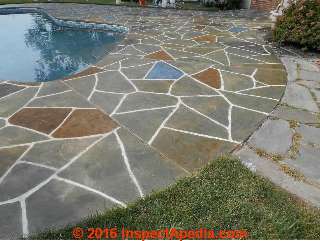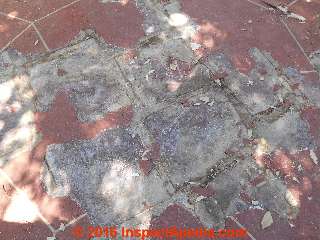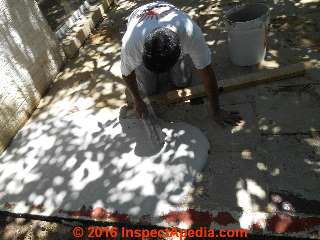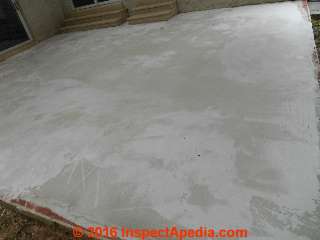 Stamped Concrete Patios & Walkways
Stamped Concrete Patios & Walkways
- POST a QUESTION or COMMENT about colored, stamped concrete patios & walkways
Colored, stamped concrete patio installation, repair & cleaning & maintenance recommendations:
This article describes and illustrates installation, repair & cleaning recommendations for colored or stained stamped-concrete patios and walkways. We discuss cleaning procedures and cleaning chemicals, de-icing alternatives to rock salt, and concrete patio maintenance.
InspectAPedia tolerates no conflicts of interest. We have no relationship with advertisers, products, or services discussed at this website.
- Daniel Friedman, Publisher/Editor/Author - See WHO ARE WE?
Installation, Repair, Cleaning & Maintenance Advice for Stamped-Concrete Patios & Walkways
 John Kapp - August 2016
John Kapp - August 2016
What is Stamped Concrete?
Stamped concrete is poured or placed concrete that has been stamped, embossed, or otherwise given an impressed pattern or design. Typically stamped concrete surfaces are patterned to resemble brick, slate, stone, tile or even wood.
A patio, walkway, or an interior floor surface may be formed of stamped concrete and as shown in our photos here a concrete stain can also be applied to impart a color or a variety of colors to the stamped concrete surface like the pool patio shown at the top of this page.
[Click to enlarge any image]
At left we illustrate an older but widely-used variation on stamped concrete products, a Permastone wall cladding that was made of stamped, embossed concrete in a stone pattern.
Contemporary stamped concrete products include a base color, an accent color, and of course the embossed pattern. - Wikipedia (2016)
Stamped concrete is one of the most ideal decorative concrete services available for pool deck use. Aside from its economical features, it also comes in a wide range of patterns and designs that homeowners can choose from.
Although it looks utterly good once installation is completed, stamped, colored concrete is prone to wear and tear, just like almost any type of walking surface. However, it doesn’t have to happen immediately as long as you keep your stamped concrete pool deck in good shape. Worried that you might be missing out on something? Here is a guide to help you maintain the beauty of a stamped concrete patio, walkway, or pool deck.
Stamped Colored or Stained Concrete Patio Installation or Repair Photos
Above we see a spalling, damaged concrete patio that formed the front entrance to a home. This concrete surface needs to be cleaned of loose debris and inspected for settlement or heaving before further repair work can proceed.
The location of this home and thus its climate and exposure, and the causes of the damaged concrete surface shown above remain to be described. Diagnostic questions: what is the city/climate, how old was the existing patio; is the damage from frost, poor original mix, something else?
Following surface cleaning and loose debris removal, the worker is pouring and troweling in place a new layer of concrete. Details of this concrete mix and its working properties remain to be described. What is the material being poured? Leveling compound, special concrete mix?
Where is this sort of concrete surface a good idea (climate, usage conditions) and where would you not recommend it?
Above is the finished leveled concrete pad before embossing with a desired pattern and the ensuing application of a concrete stain. A description of the staining procedure and recommended products remain to be described.
Above: the concrete entry patio repair has been completed, including stain and application of sealant. A description of recommended sealant remains to be described. When & how is a coloring stain applied? What stain products? What sealer is used atop the stained concrete? What products?
What are the key elements that make for a successful or un-successful re-surfacing and staining/coloring job?
How is your process different from what I've described at CONCRETE COLORING & POLISHING ?
Stamped Colored or Stained Concrete Patio Cleaning & Maintenance
Although it looks utterly good once installation is completed, colored or stained stamped-concrete is prone to wear and tear, just like almost any type of walking surface. However, it doesn’t have to happen immediately as long as you keep the stamped concrete pool deck in good shape. Here is a guide to help you maintain the beauty of your pool patio or walkway.
The process of applying a color or stain to concrete surfaces is detailed separately
at CONCRETE COLORING & POLISHING.
Sweep and Wash the Stamped Concrete Surface
To avoid dirt build-up, any flooring needs to be swept and washed occasionally. Dirt buildup can harden and become difficult to remove if left unattended.
Watch out: You may use a pressure washer to clean colored stamped concrete surfaces but make sure that it is in medium setting only to prevent damage.
Use Only Mild Cleaning Products on Stamped Concrete Surfaces
A mild detergent mixed with water is an ideal floor cleaner for stamped concrete. Also, make sure that it is neutral and not acid-based to prevent any chemical reactions that may affect color and durability.
Recommended Floor Cleaners for Stamped Concrete:
- pH Neutral Cleaners – These are floor-cleaning products that contain only basic, non-acidic ingredients, such as water or soap. These can be purchased in hardware stores or a janitorial supply outlet.
- Non-Acid-Based Specialty Products – Examples would be efflorescence removers. Although these are effective, they can be quite difficult to find.
Cleaner Ingredients to Avoid When Cleaning Stamped - Stained Concrete
- Ammonia
- Bleach
- Hydrochloric acid (muriatic acid)
- Potassium Hydroxide
- Sodium Hydroxide
- Sulfuric acid
Watch out: all of the chemicals listed above are dangerous and can cause severe burns or other injuries if in skin contact or blindness if in eye contact.
Watch out: These chemicals may also remove the desired color from a stained or stamped concrete surface.
Avoid Deicing Salts When Cleaning Stamped Stained Concrete
Keep salt off your stamped concrete surface at least for the first winter since the stamped concrete overlay was installed. Sealers tend to weaken and fade in areas where deicing salts are present.
Rock salt encourages snow to remain liquid so it would not freeze into icy thin slabs above your pool deck. However, this freezing and thawing process can be quite damaging to concrete. It weakens the sealer as it gets absorbed into the concrete.
Alternatives to Deicing Salts for Stamped Concrete Patios or Walkways
In addition to improving walking traction on slippery surfaces, dark materials such as coffee grinds or sand, by absorbing heat from sunlight, may melt some ice or snow, though the remaining water will of course re-freeze at night. But keep in mind that when snow and ice are gone completely, you'll probably have to sweep these up.
- Alfalfa meal, often used as a fertilizer, is also an environment-friendly alternative. Aside from melting snow, it is also grainy enough to increase slip-resistance.
- Calcium Chloride acts like deicing salts but is less harsh on concrete.
- Cat litter is effective in providing a non-skid surface when applied on top of snow.
- Coffee grinds have the ability absorb sunlight, thus, making it capable of melting the snow or ice underneath it. However coffee grinds, may actually cause staining on concrete or other outdoor surfaces.
- Sand or light gravel on top of the snow or ice. These materials will not completely melt the ice or snow on top of your pool deck but it will increase traction, thus, making it safe enough to walk on.
- Sugar beet juice is quite effective and very environment-friendly. It helps lower ice and snow melting points. Left in place when weather warms, it will also attract ants and perhaps other pests.
Re-coat Stamped Concrete Patios or Walkways Sealer When Needed
Stamped concrete is warranted to last for 2 years before any repair or resealing is necessary.
However, if you notice one area where color or shine has faded, get in touch with a professional decorative concrete installer and have it assessed. This way, you will know if a redcoat is needed and what type of sealer should be used. To learn about what type of sealer would work best, check Concrete Network guide cited below
Sources for Stamped Concrete or Other Concrete Surface Sealers
Here are some sealers for use on concrete surfaces:
- RadonSeal Deep-Penetrating Concrete Sealer, Website: http://www.radonseal.com/, Tel: USA: Toll-free 1-800-472-0603 or 203-225-0367, CANADA: 905-841-3535. RadonSeal's sealer products include concrete sealer, masonry stain and sealer, water-repellent sealer, and subsurface elastomeric sealer. They also offer waterproofing and concrete repair products.
- Increte Systems' Clear-Seal, Website: http://www.increte.com/, Tel: (813) 886-8811, Toll free: (800) 752-4626. Increte Systems provides decorative concrete products such as solvent and water based clear concrete sealers and paver sealers.
- PS101 Siliconate Multi-Surface WB Penetrating Sealer, Website: http://www.concretesealersusa.com/, Tel: 1.888.583.2991. Concrete Sealers USA’s sealers include penetrating and topical concrete sealers. They also offer stains, dyes, cleaners, and repair kits.
- Sure Klean Weather Seal, Website: http://www.prosoco.com/, Tel: (800) 255-4255. Prosoco sealers and concrete protection products include water repellent protection, graffiti removal and protection, as well as air and water barriers.
At InspectAPedia we have no business nor financial connection with any manufacturer or service provider discussed at our website. Independently-placed advertisements & bookstore sales help support the website. - ABOUT InspectApedia.com
About the Author
- John Kapp is a concrete design consultant in Los Angeles, CA. His expertise include stamped, stained, stenciled, and other types of decorative concrete applications for indoor and outdoor floors of both residential and commercial properties. Mr. Kapp can be reached at Sundek Decorative Concrete Surfaces Company, Los Angeles, CA, USA, Tel: 323-319-5230, Email: john.kapp80@gmail.com Website: http://www.losangelesdecorativeconcrete.com/
...
Continue reading at CONCRETE STAINS: ID & REMOVAL or select a topic from the closely-related articles below, or see the complete ARTICLE INDEX.
Or see these related articles
CONCRETE SLAB CRACK EVALUATION
STAIN DIAGNOSIS on BUILDING EXTERIORS
STONE, STUCCO & BRICK CLEANING METHODS
Suggested citation for this web page
STAMPED CONCRETE CLEANING at InspectApedia.com - online encyclopedia of building & environmental inspection, testing, diagnosis, repair, & problem prevention advice.
Or see this
INDEX to RELATED ARTICLES: ARTICLE INDEX to BUILDING STAINS
Or use the SEARCH BOX found below to Ask a Question or Search InspectApedia
Ask a Question or Search InspectApedia
Try the search box just below, or if you prefer, post a question or comment in the Comments box below and we will respond promptly.
Search the InspectApedia website
Note: appearance of your Comment below may be delayed: if your comment contains an image, photograph, web link, or text that looks to the software as if it might be a web link, your posting will appear after it has been approved by a moderator. Apologies for the delay.
Only one image can be added per comment but you can post as many comments, and therefore images, as you like.
You will not receive a notification when a response to your question has been posted.
Please bookmark this page to make it easy for you to check back for our response.
IF above you see "Comment Form is loading comments..." then COMMENT BOX - countable.ca / bawkbox.com IS NOT WORKING.
In any case you are welcome to send an email directly to us at InspectApedia.com at editor@inspectApedia.com
We'll reply to you directly. Please help us help you by noting, in your email, the URL of the InspectApedia page where you wanted to comment.
Citations & References
In addition to any citations in the article above, a full list is available on request.
- "7 (Better Alternatives to Salt for De-Icing", Mr. Pavement, 855 Cressman Road, Harleysville, PA 19438 USA, Tel: 1-888-PAVEMENT, retrieved 2016/07/29, original source: http://www.mrpavement.com/blog/general-information/7-better-alternatives-to-salt-for-de-icing/
- Sullivan, Chris, "Choosing a Concrete Cleaner or Degreaser", ConcreteNetwork.com, [Website, no physical address information provided] retrieved 2016/07/29, original source: http://www.concretenetwork.com/concrete-cleaner/
- "Concrete Sealers - Buying Tips", ConcreteNetwork.com, [Website, no physical address information provided] retrieved 2016/07/29, original source: http://www.concretenetwork.com/products-sealer/buying-tips.html
Website excerpt:
The Concrete Network's purpose is to educate homeowners, contractors, builders, and designers on popular concrete techniques and applications. - Cleaning agent. (n.d.). Retrieved July 28, 2016, from https://en.wikipedia.org/wiki/Cleaning_agent
- Wikipedia Web: https://www.wikipedia.org/ provided background information about some topics discussed at this website provided this citation is also found in the same article along with a " retrieved on" date.
Because Wikipedia and other website entries can be amended in real time, we cite the retrieval date of such citations and we do not assert that the information found there is always authoritative.
- "Cleaning Agent", Wikipedia, retrieved 2016/07/29, original source: https://en.wikipedia.org/wiki/Cleaning_agent
- "Stamped concrete", Wikipedia, retrieved 2016/07/29, original source: https://en.wikipedia.org/wiki/Stamped_concrete
- In addition to citations & references found in this article, see the research citations given at the end of the related articles found at our suggested
CONTINUE READING or RECOMMENDED ARTICLES.
- Carson, Dunlop & Associates Ltd., 120 Carlton Street Suite 407, Toronto ON M5A 4K2. Tel: (416) 964-9415 1-800-268-7070 Email: info@carsondunlop.com. Alan Carson is a past president of ASHI, the American Society of Home Inspectors.
Thanks to Alan Carson and Bob Dunlop, for permission for InspectAPedia to use text excerpts from The HOME REFERENCE BOOK - the Encyclopedia of Homes and to use illustrations from The ILLUSTRATED HOME .
Carson Dunlop Associates provides extensive home inspection education and report writing material. In gratitude we provide links to tsome Carson Dunlop Associates products and services.





